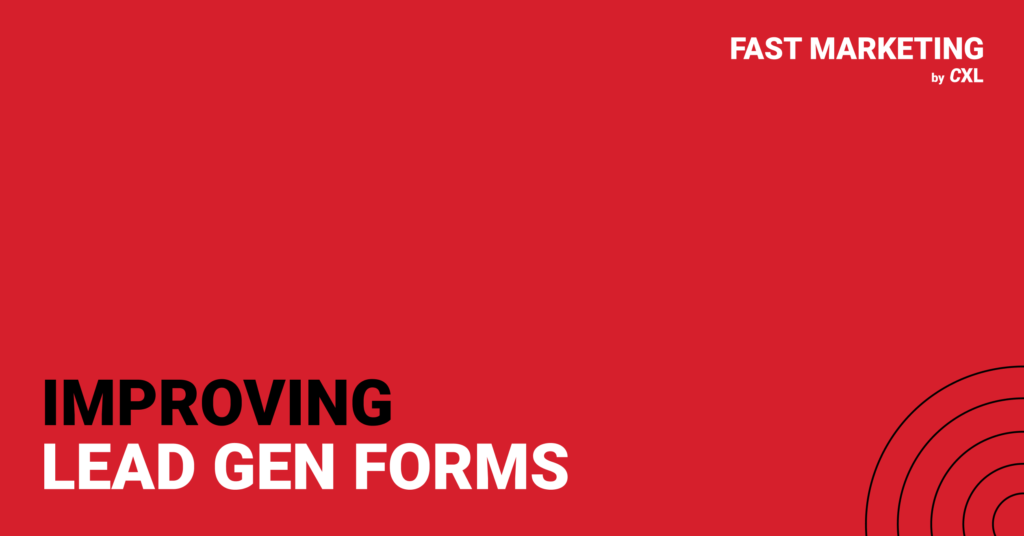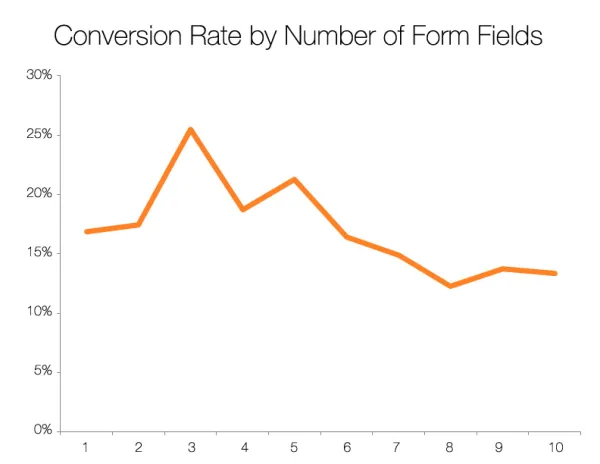I added an extra qualifying step to the lead gen form of a B2B software company. While it sounds like the opposite of your usual “CRO best practices,” the added friction brought a 20% increase in conversion rate.
Want to read the Fast Marketing tactic on this topic? Skip directly to it here.
Get tactics like these straight to your inbox: sign up for the Fast Marketing Newsletter by CXL.
Table of contents
Getting forms right (and removing roadblocks in your funnel)
By Pablo García, Content Lead at CXL.
The lead gen form sits at the core of every landing page.
When visitors arrive on your page, you aim for them to easily locate and fill out the form, right? It serves as the gateway to your conversion funnel, the initial point of contact with potential leads.
Now, if you wonder whether your form is too lengthy, you should switch the button color, or in-field labels can ease the process, the answer to those questions lies in conducting tests yourself.
Still, you could grasp the steps in optimizing lead gen forms just by following the empirically backed form design principles.
An unoptimized lead gen form acts as a barrier. It slows folks down, raises uncertainties, and disrupts the conversion flow. Neglecting to identify and fix these hurdles means your form is leaking potential profits.

On the flip side, an optimized lead gen form is a welcome gesture. It feels like a natural step, doesn’t raise alarms, and it’s user-friendly. It doesn’t hinder your visitor’s journey.
The two keys to optimizing a lead gen form
There are two fundamental traits of an optimized lead gen form:
A perfected value proposition
Lead gen forms are transactions, and thinking of them as anything else is a mistake. You’re requesting information from your visitors. If you can’t offer something in return, you won’t get much. What’s your value proposition? What’s motivating your visitors to fill in the form?
Your value proposition needs to clearly show what your readers gain by completing the form. If it makes people question what will happen after clicking the “submit” button, you’re missing the mark.
That clarity normally means the opposite of sifting through tons of text to grasp an offer, so, while ample and detailed info on a page matters for conversions, a concise, compelling, and straight-to-the-point value proposition is your lead-in.
On top of that, there are also different types of value propositions, and addressing the right ones for your company and your product is key.
Reduced friction
Lead gen forms should be as smooth as possible. Trimming fields is a way to reduce friction along the customer journey, and can be especially crucial for boosting conversions at the bottom of the funnel.
Most forms drag on too long. It’s a case of “greedy marketer syndrome”: we think we need every piece of data, but to drive more form completions, you should actually ask for less, right?
Instead of having to punch in data, optimized forms are so effortless that visitors don’t have to dwell on it. They simply navigate through the process without encountering barriers.
You can optimize your value proposition or call to action buttons all you want, but if your signup flow contains too much friction, you’re leaving money on the table.
Sadhana Balaji, Head of Brand and Content at Atomicwork
Short lead forms are proven to work better, with Dan Zarella finding that the conversion rate normally decreases as the number of fields in the lead form increases:
In some cases though, and as we explained before when writing about reducing form fields, an easier and simpler form may not always lead to more conversions. Read on:
Increasing conversion rate by 20% by actually adding friction
By Shiva Manjunath, Senior Web Product Manager at Motive.
Originally published in the Fast Marketing newsletter.
Surprisingly, in some cases lead gen forms might perform better with the right amount of friction. Adding qualifying steps can help build trust.
These extra steps and qualifying questions prior to personal information requests signal to leads that the company seeks a productive conversation. Leads appreciate the efforts to understand them better, leading them to be more open to engaging with the sales team.
TL;DR for this marketing tactic
- The company: B2B software company.
- The goal: Increase the CVR of the lead gen form, without reducing MQL rates.
- The tactic: Add an extra qualifying step to the form.
- The result: 20% increase in the CVR.
What’s the fast marketing tactic?
A B2B software company was looking to improve the CVR (conversion rate) of their lead gen form, without losing lead quality. At the time, they had a multi-step form in place.
The initial hypothesis was that the form was too long. So the first test was to shorten it.
Surprisingly, however, shortening the form led to a significant drop in both CVR and MQLs (marketing-qualified leads).
So the team tested the anti-hypothesis: making the form longer by adding an extra step.
Specifically, they added a first step that asked users whether they currently had a similar software solution in place. This was done as a way to capture more data for the sales team, but also to be an “easy to answer” question to get more people into the form.
What was the result?
By adding this extra step to their existing multi-step form, the team achieved:
- 20% increase in the CVR.
- 10% increase in MQLs.
In addition, the sales team now has more information on each lead, which helps them improve their sales conversations and conversions.
The extra information also made it possible to further personalize the lead form for each user, giving them a different flow of questions based on whether they needed to replace a solution, or were new to the solution entirely.
Why does it work?
The hypothesis is that—for this company and their target audience—the added, qualifying steps were important in building trust. Yes, reducing friction may not work best in all cases.
Adding steps to the form, as well as placing qualifying questions ahead of requests for personal information, tells leads that the company is looking to have a productive conversation with them.
Leads appreciate that the questions were designed to get to know them and better cater to their needs. They are then more motivated to accept a phone call from the sales team.
If you want to expand your knowledge further and become a master of CRO yourself, take the Minidegree in Conversion Optimization.
Do you want more tactics like these?
- Sign up to our Fast Marketing Newsletter to get these straight to your inbox.
- Read how to increase demo signups by collecting buyer input.
- See all fast marketing tactics.





